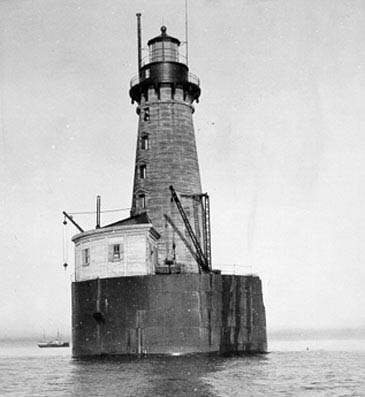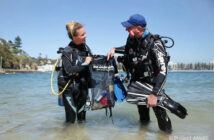
The most significant navigational risk on Lake Superior was a reef, which is where the Stannard Rock Light is situated. One of the top ten engineering achievements in the United States is considered to be the exposed crib of the Stannard Rock Light. It is the farthest lighthouse (from shore) in the United States at 24 miles (39 km) from the closest piece of land. It was known as “The Loneliest Place in the World” and was one of the “stag stations” that was exclusively staffed by men.
The lighthouse was automated in 1962, and the US Coast Guard continues to operate it as a navigational aid. It is off-limits to the general public and only accessible by boat or airplane.
This underwater mountain, which measures 0.25 miles (0.40 km) in length and has a maximum depth of 4 feet (1.2 m) and a mean depth of 16 feet (4.9 m), was first spotted in 1835 by Captain Charles C. Stannard of the ship John Jacob Astor. This reef, which was “atop a mile long reef” more than 50 miles northwest of Marquette, posed the greatest threat to navigation on Lake Superior, and it was first identified by a day beacon in 1868. At the time, tests were conducted to see if a light could endure in such a hostile environment. In 1866, a temporary marker was erected there. A lighthouse had to be built as a result of the Soo Locks opening and the booming increase in trade between Duluth, Minnesota, and the lower Great Lakes. Captain Stannard was honoured with a lighthouse. Of all the lighthouses in the United States, the Stannard Rock Light is the furthest from land at 24 miles (39 km) away. A superior lake trout fishery can be found all year long thanks to Stannard Rock Reef. On August 17, 1997, Lucas Lanczy, then 16 years old, caught the 61 pounds, 8 ounces (27.9 kg), state record lake trout for Michigan at Stannard Rock Reef using 12-pound (5.4 kg) line.
Maintenance workers had to hack away the ice around the door to get to the men in the early winter when Lake Superior’s waves crashed against the stone tower of the Stannard Rock Light. Before the keepers at the Stannard Rock Light received help in the event of an illness, mishap, or fire, it might take days or even weeks. It was designated as a “stag station” where only men could work because it was one of the rock lighthouses. The Stannard Rock Light was referred to by the keepers as the “Loneliest Place in the World”. It has always held the title of being the “loneliest place” in the contiguous United States as well.
For 60 years, the Stannard Rock Light keepers used flammable illuminants to light up the lantern and the dwellings; the lighthouse wasn’t electrified until after World War II. A few years later, the buildings on the pier were completely destroyed, and the interior of the tower was severely damaged, due to an explosion of gasoline and propane tanks used to fuel the station plant. Three keepers were stranded on the concrete pier at the base of the tower for three days before a passing ship discovered them and alerted the Coast Guard after the explosion claimed the life of one of the keepers. The kind Woodrush came to the men’s aid.
The station was automated in 1962 after the Coast Guard repaired the fire damage and decided the location was too isolated and dangerous. A 3,000 candlepower light was used in place of the previous 1,400,000 candlepower one. The second order of 12 bulls-eyed Fresnel lenses was painstakingly disassembled by the Coast Guard, carried down 141 tower stairs, packed in six wooden crates, and then lowered by block and tackle 80 feet (24 m) to the crib for shipment. The Fresnel lens was located 37 years later at the Coast Guard Academy’s storage facility in New London, Connecticut, after a protracted search. In 2000, the tower’s base unit for the lens was moved to the museum. The camera lens is now visible at the Marquette Maritime Museum.
The Stannard Rock Light is still a working navigational aid and belongs to the Coast Guard. The lighthouse is off-limits to the general public and can only be seen from an airplane or boat. Having warned mariners away from the perilous reef for more than a century, the lighthouse was given a new purpose in 2008 when researchers installed equipment atop the tower to determine whether increased evaporation was the reason for the Great Lakes’ declining water levels.
It is possible to reach the lighthouse by boat, but guests are not permitted to go inside.
It was listed on the National Register of Historic Places in 1971.








